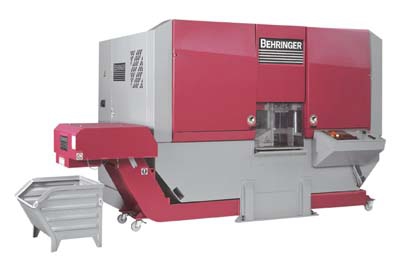
Behringer has expanded its HBM series of high-performance bandsaws to include the new HBM-SC series. The HBM440A-SC and HBM540A-SC feature SC (speed cutting) technology which enables ultra high-speed cutting of virtually all metals including tool steels, stainless steel and other materials traditionally presenting slow cut rates.
Productivity tests conducted at Behringer showed that conventional band sawing machines with bimetal saw blades can cut solid chromium-manganese material with a diameter of 6" at a rate of about 12 sq."/min. Adding a carbide-tipped blade boosts this rate to about 20 sq."/min. With SC technology installed, the approximate cut rate achieved in the tests was near 77.5 sq."/min which is more than quadruple the rate of a conventional bandsaw.
"In plain terms," said Richard Klipp, Behringer president, "a single bandsaw with SC installed can make a cut in about a half a minute whereas a conventional bandsaw might take up to two minutes. One of our saws with SC technology can probably out-produce three standard machine saws partly because there is a much higher volume of filtered flood coolant used, and also because the chip removal system is capable of handling massive amounts of debris."
To maximize cutting speed capability Behringer has dynamically re-engineered the HBM saw frame so that it channels the buildup of forces away from the work area. This permits optimized band clamping to reduce vibration and increase precision movement. Newly designed band guides are fitted with nozzles which spray coolant directly into the kerf. Coupled with a high volume coolant pump, this keeps blades and materials as cool as possible during high speed cutting enabling longer periods of uninterrupted throughput when compared to conventional bandsaws.
The HBM-SC sawing blade downfeed is driven by a ball screw powered with a heavy-duty gearbox and a high horsepower motor with a torque drive of 35 HP. This provides the controlled application of downfeed power required for precise, accurate movement of the blade through the material being cut.
Downfeed power is then balanced against blade wear via a blade pressure monitor which is linked to a servo-controlled cutting pressure sensing system. This power/pressure balance assures that the material feed rate is always maximized without overloading the blade. This results in the longest possible blade life.
Because SC technology yields higher rates of stock removal, an unusually high volume of chips are produced. Two self-adjusting brushes clean the saw band while the saw operates. Falling into a funnel shaped flume, the chips are guided to a dual conveyor in the machine bed. This is a high capacity, high efficiency chip removal system allowing operators to achieve and maintain high productivity levels without being forced to stop work in order to clear the work area.
Contact Details
Related Glossary Terms
- bandsaw
bandsaw
Machine that utilizes an endless band, normally with serrated teeth, for cutoff or contour sawing. See saw, sawing machine.
- bandsaw blade ( band)
bandsaw blade ( band)
Endless band, normally with serrated teeth, that serves as the cutting tool for cutoff or contour band machines.
- coolant
coolant
Fluid that reduces temperature buildup at the tool/workpiece interface during machining. Normally takes the form of a liquid such as soluble or chemical mixtures (semisynthetic, synthetic) but can be pressurized air or other gas. Because of water’s ability to absorb great quantities of heat, it is widely used as a coolant and vehicle for various cutting compounds, with the water-to-compound ratio varying with the machining task. See cutting fluid; semisynthetic cutting fluid; soluble-oil cutting fluid; synthetic cutting fluid.
- cutting speed
cutting speed
Tangential velocity on the surface of the tool or workpiece at the cutting interface. The formula for cutting speed (sfm) is tool diameter 5 0.26 5 spindle speed (rpm). The formula for feed per tooth (fpt) is table feed (ipm)/number of flutes/spindle speed (rpm). The formula for spindle speed (rpm) is cutting speed (sfm) 5 3.82/tool diameter. The formula for table feed (ipm) is feed per tooth (ftp) 5 number of tool flutes 5 spindle speed (rpm).
- feed
feed
Rate of change of position of the tool as a whole, relative to the workpiece while cutting.
- kerf
kerf
Width of cut left after a blade or tool makes a pass.
- sawing
sawing
Machining operation in which a powered machine, usually equipped with a blade having milled or ground teeth, is used to part material (cutoff) or give it a new shape (contour bandsawing, band machining). Four basic types of sawing operations are: hacksawing (power or manual operation in which the blade moves back and forth through the work, cutting on one of the strokes); cold or circular sawing (a rotating, circular, toothed blade parts the material much as a workshop table saw or radial-arm saw cuts wood); bandsawing (a flexible, toothed blade rides on wheels under tension and is guided through the work); and abrasive sawing (abrasive points attached to a fiber or metal backing part stock, could be considered a grinding operation).
- sawing machine ( saw)
sawing machine ( saw)
Machine designed to use a serrated-tooth blade to cut metal or other material. Comes in a wide variety of styles but takes one of four basic forms: hacksaw (a simple, rugged machine that uses a reciprocating motion to part metal or other material); cold or circular saw (powers a circular blade that cuts structural materials); bandsaw (runs an endless band; the two basic types are cutoff and contour band machines, which cut intricate contours and shapes); and abrasive cutoff saw (similar in appearance to the cold saw, but uses an abrasive disc that rotates at high speeds rather than a blade with serrated teeth).
- tool steels
tool steels
Group of alloy steels which, after proper heat treatment, provide the combination of properties required for cutting tool and die applications. The American Iron and Steel Institute divides tool steels into six major categories: water hardening, shock resisting, cold work, hot work, special purpose and high speed.






